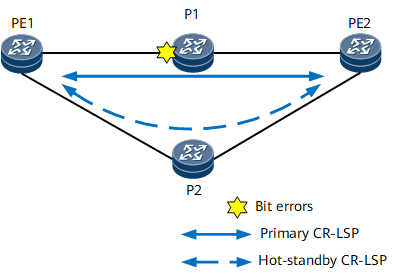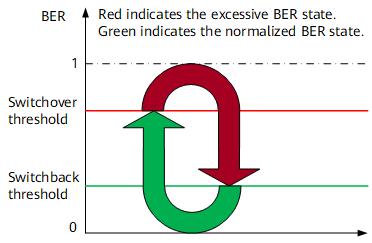Bit-Error-Triggered RSVP-TE Tunnel Switching
Background
To cope with link bit errors along an RSVP-TE tunnel and reduce the impact of bit errors on services, deploy bit-error-triggered RSVP-TE tunnel switching. After the deployment is complete, service traffic is switched from the primary CR-LSP to the backup CR-LSP if bit errors occur.
Implementation Principles
On the network shown in Figure 1, trigger-LSP bit error detection must be enabled on each node's interfaces on the RSVP-TE tunnels. To implement dual-ended switching, configure the RSVP-TE tunnels in both directions as bidirectional associated CR-LSPs. If a node on a CR-LSP detects bit errors in a direction, the ingress of the tunnel obtains the BER of the CR-LSP after BER calculation and advertisement. For details, see Bit Error Detection.
The ingress then determine the bit error status of the CR-LSP based on the BER threshold configured for the RSVP-TE tunnel. For rules for determining the bit error status of the CR-LSP, see Figure 2.
If the BER of the CR-LSP is greater than or equal to the switchover threshold of the RSVP-TE tunnel, the CR-LSP is always in the excessive BER state.
If the BER of the CR-LSP falls below the switchback threshold, the CR-LSP changes to the normalized BER state.
After the bit error statuses of the primary and backup CR-LSPs are determined, the RSVP-TE tunnel determines whether to perform a primary/backup CR-LSP switchover based on the following rules:
If the primary CR-LSP is in the excessive BER state, the RSVP-TE tunnel attempts to switch traffic to the backup CR-LSP.
If the primary CR-LSP changes to the normalized BER state or the backup CR-LSP is in the excessive BER state, traffic is switched back to the primary CR-LSP.
The RSVP-TE tunnel in the opposite direction also performs the same switchover, so that traffic in the upstream and downstream directions is not transmitted over the CR-LSP with bit errors.
Usage Scenario
If RSVP-TE tunnels are used as public network tunnels, deploy bit-error-triggered RSVP-TE tunnel switching to cope with link bit errors along the tunnels.

